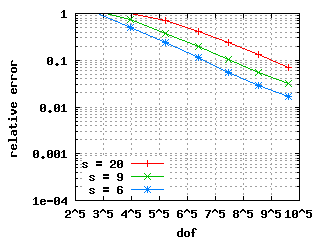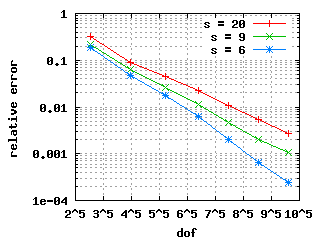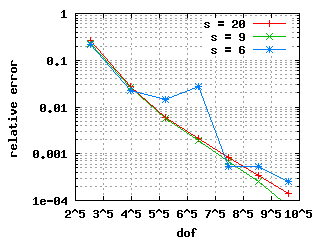The benchmark problems are presented in the page BENCHMAX.
Authors, affiliation
Authors
Philipp
FRAUENFELDER, Kersten SCHMIDT,
Christoph SCHWAB.
Affiliation
ETH Zürich, Seminar for Applied Mathematics
Method and code
The method is the weighted Regularization.
It consists in adding to the bilinear form \int_Domain curl u . curl v dx a part in s \int_Domain div u div v d\mu with, instead the standard measure dx on the Domain, a measure of the form d\mu = \rho(x) dx where \rho(x) is a suitable weight (it tends to zero with a special rate as x tends to the singular support of the solution). s is a scaling parameter not affecting physical Eigenmodes.
Reference 1:
Martin COSTABEL, Monique DAUGE,
"Weighted Regularization of Maxwell Equations in Polyhedral
Domains. A rehabilitation of nodal finite elements",
Numer. Math., 93(2): 239-277, 2002.
Reference 2:
Philipp FRAUENFELDER, Christian LAGE,
"Concepts-An Object-Oriented Software Package for Partial
Differential Equations", M2AN Math. Model. Numer. Anal. 36(5): 937-951, 2002.
Reference 3:
Philipp FRAUENFELDER,
"hp-Finite Element Methods for
Anisotropically, Locally Refined Meshes in Three Dimensions", Doctoral
Dissertation, in preparation. (To be found
online.)
Reference 4:
Code Concepts
Reference 5:
Mark AINSWORTH and Joe COYLE,
"Hierarchic hp-edge element families for Maxwell's
equations on hybrid quadrilateral/triangular meshes",
Comput. Methods Appl. Mech. Engrg. 190(49-50): 6709-6733, 2001.
Reference 6:
Paul David LEDGER,
"An hp-adaptive finite element procedure for
electromagnetic scattering problems", Doctoral Dissertation,
University of Wales, Nov. 2001.
Technical data:
Computations in double precision arithmetics on a Sun-Fire-880
running Solaris 2.8. Eigensolver: ARPACK together
with Umfpack as
direct sparse linear solver.
Results
Maxwell eigenvalues in 2DomA (L-shape), (20031112)
Computed by a Galerkin approximation with a geometric mesh with increasing number of layers n and linearly distributed polynomial degree (between 2 in the smallest two layers and n+1 in the largest layer).
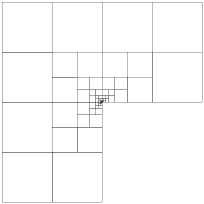
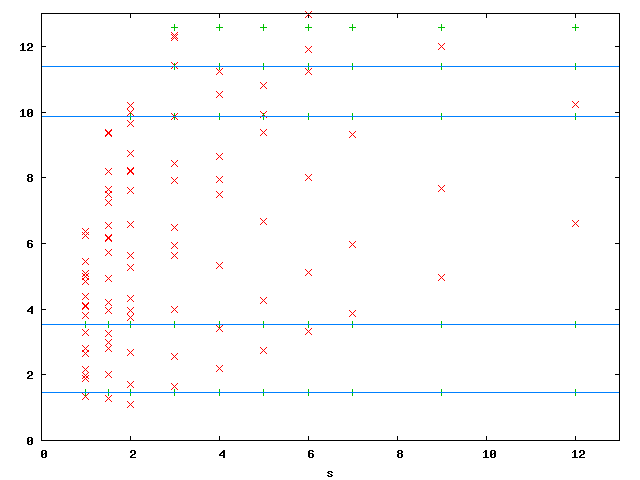
In the above plot (15770 dofs), red are spurious Eigenvalues, green are physical Eigenvalues, horizontal blue lines are 'exact' values from Benchmax. Below are the numeric values of the first three physical Eigenvalues for different number of layers n. We chose s = 9.
| N = 92 n = 2 | N = 254 n = 3 | N = 524 n = 4 | N = 920 n = 5 | N = 1460 n = 6 |
|---|---|---|---|---|
| 2.86573959840516 | 2.13750910748911 | 1.78898572721029 | 1.61889362116687 | 1.53736021852868 |
| 3.65505284848033 | 3.57396281907217 | 3.54665671778786 | 3.53757610395472 | 3.53486006898055 |
| 9.94384679647975 | 9.87085428640141 | 9.8696194331942 | 9.86960450926821 | 9.86960440165983 |
| N = 2162 n = 7 | N = 3044 n = 8 | N = 4124 n = 9 | N = 5420 n = 10 | N = 6950 n = 11 |
| 1.50117163414723 | 1.48594500302172 | 1.47976090879924 | 1.47727860896356 | 1.47628579229304 |
| 3.5341913131655 | 3.53405875446339 | 3.5340358390327 | 3.53403208704629 | 3.53403148248334 |
| 9.86960440109168 | 9.86960440108937 | 9.86960440108936 | 9.86960440108925 | 9.86960440108923 |
| N = 8732 n = 12 | N = 10784 n = 13 | N = 13124 n = 14 | N = 15770 n = 15 |
|
| 1.47588720508015 | 1.47572764092995 | 1.47566392437459 | 1.47563855438825 | |
| 3.53403138526762 | 3.53403136972463 | 3.53403136725283 | 3.53403136686121 | |
| 9.86960440108941 | 9.86960440108869 | 9.86960440103989 | 9.86960440106789 |
The convergence histories below for the 1st, 2nd and 3rd Eigenvalue
show three different curves each: for the values s = 9, s = 6 and s = 2.
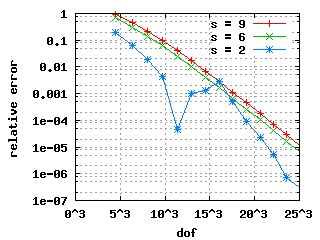
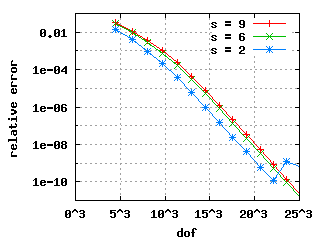
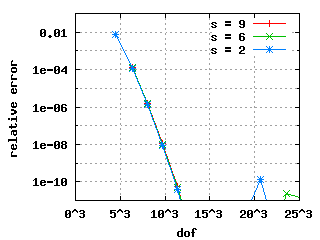
Maxwell eigenvalues in 2DomB (Cracked domain), (20031112)
Computed by a Galerkin approximation with a geometric mesh with increasing number of layers n and linearly distributed polynomial degree (between 2 in the smallest two layers and n+1 in the largest layer).
We have meshed the whole domain despite of its symmetry.
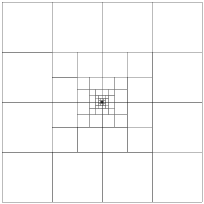
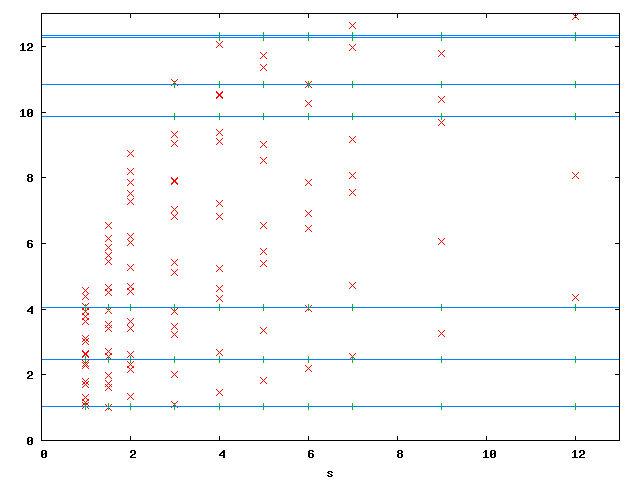
In the above plot (21028 dofs), red are spurious Eigenvalues, green are physical Eigenvalues, horizontal blue lines are 'exact' values from Benchmax. Below are the numeric values of the first three physical Eigenvalues for different number of layers n. We chose s = 9.
| N = 28 n = 1 | N = 124 n = 2 | N = 340 n = 3 | N = 700 n = 4 | N = 1228 n = 5 |
|---|---|---|---|---|
| 0 | 0 | 0 | 1.58777378390929 | 1.32620845736318 |
| 2.48596169911994 | 2.4686647564103 | 2.46740590431364 | 2.46740111987976 | 2.46740110030937 |
| 4.20889371256103 | 4.09240705319858 | 4.05977414811014 | 4.0507501786559 | 4.04794410873117 |
| N = 1948 n = 6 | N = 2884 n = 7 | N = 4060 n = 8 | N = 5500 n = 9 | N = 7228 n = 10 |
| 1.1837069859702 | 1.10935774375835 | 1.07158738859862 | 1.05275810922445 | 1.04339680492742 |
| 2.46740110027244 | 2.46740110027235 | 2.46740110027234 | 2.46740110027227 | 2.46740110027231 |
| 4.04714649402212 | 4.04696249807443 | 4.04693055206994 | 4.04692598281576 | 4.04692538017452 |
| N = 9268 n = 11 | N = 11644 n = 12 | N = 14380 n = 13 | N = 17500 n = 14 | N = 21028 n = 15 |
| 1.03873979945416 | 1.03640903456255 | 1.03524249059564 | 1.03465847420399 | 1.03436626682797 |
| 2.46740110027233 | 2.46740110027229 | 2.46740110027132 | 2.46740110026939 | 2.46740110027262 |
| 4.04692530272451 | 4.04692529283525 | 4.0469252915798 | 4.0469252914196 | 4.04692529140291 |
The convergence histories below for the 1st, 2nd and 3rd Eigenvalue
show three different curves each: for the values s = 9, s = 6 and s = 2.
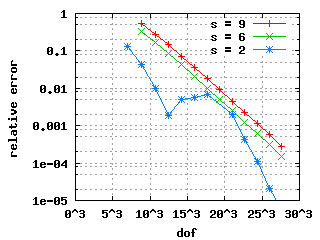
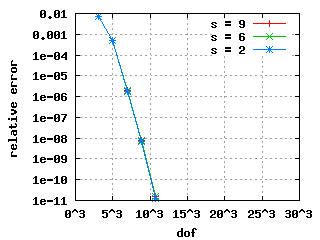
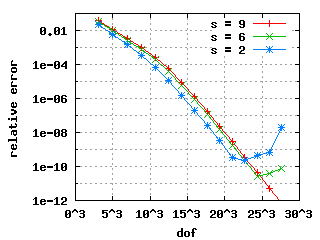
Maxwell eigenvalues in 2DomE (Square for transmission problems, ε1 = 0.5), (20040408, 20040505, 20040511)
Computed by a Galerkin approximation with a geometric mesh with increasing number of layers n and linearly distributed polynomial degree (between 2 in the smallest two layers and n+1 in the largest layer). We have used three different methods:
| Plain Weighted Regularization | Weighted Regularization with Node Doubling | Edge Elements | |||||||||||||||||||||||||||||||||||||||
|---|---|---|---|---|---|---|---|---|---|---|---|---|---|---|---|---|---|---|---|---|---|---|---|---|---|---|---|---|---|---|---|---|---|---|---|---|---|---|---|---|---|
Mesh | |||||||||||||||||||||||||||||||||||||||||
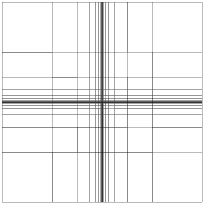 |
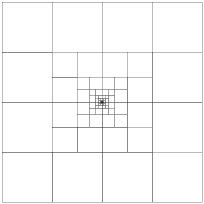 |
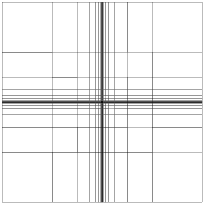 |
|||||||||||||||||||||||||||||||||||||||
Eigenvalues | |||||||||||||||||||||||||||||||||||||||||
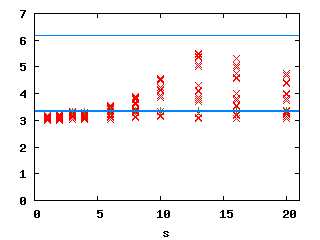
|
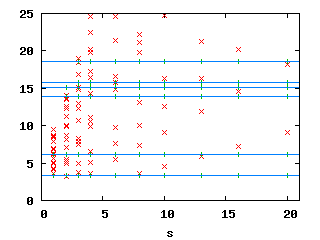
|
|
|||||||||||||||||||||||||||||||||||||||
| In the above plots (20766 and 7680 dofs, click for larger version), red are spurious Eigenvalues, green are physical Eigenvalues, horizontal blue lines are 'exact' values from Benchmax. Below are the numeric values of the first three physical Eigenvalues for different number of layers n. We chose s = 10. | |||||||||||||||||||||||||||||||||||||||||
|
|
||||||||||||||||||||||||||||||||||||||||
Relative errors with benchmarkThe convergence histories below for the 1st, 2nd and 3rd Eigenvalue show three different curves each: for the values s = 10, s = 6 and s = 2. In the case of edge elements, no s is used. |
|||||||||||||||||||||||||||||||||||||||||
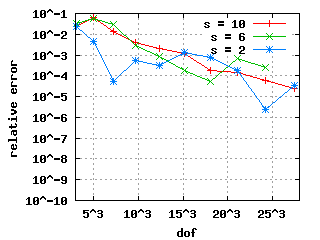 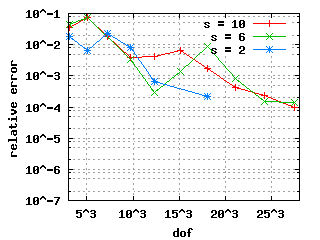 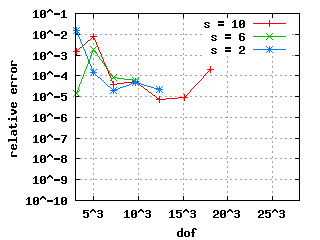
|
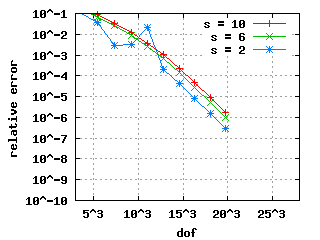 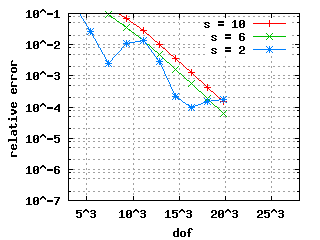 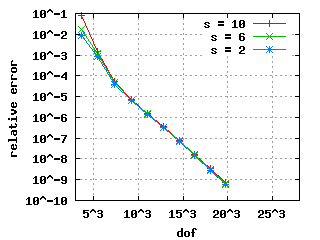
|
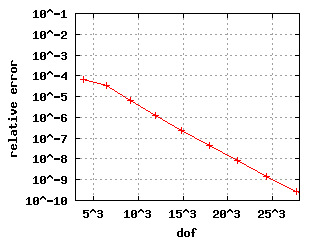 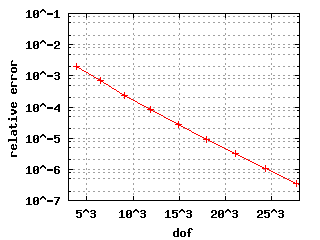 
|
|||||||||||||||||||||||||||||||||||||||
| The descent for the weighted regularization with node doubling (pictures in the middle) is steeper because it uses only a vertex mesh as opposed to edge meshes in the other two cases. | |||||||||||||||||||||||||||||||||||||||||
Maxwell eigenvalues in 2DomE (Square for transmission problems, ε1 = 1e-2), (20040527)
Computed by a Galerkin approximation with a geometric mesh with increasing number of layers n and linearly distributed polynomial degree (between 2 in the smallest two layers and n+1 in the largest layer). We have used three different methods:
The same mesh was used for all three methods.

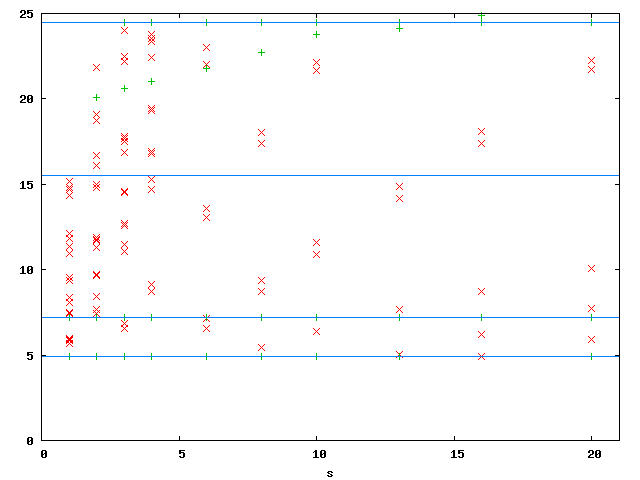
In the above plot (7680 dofs), red are spurious Eigenvalues, green are physical Eigenvalues, horizontal blue lines are 'exact' values from Benchmax. Below are the numeric values of the first three physical Eigenvalues for different number of layers n. We chose s = 2.
| Weighted Regularization with Node Doubling | Edge Elements | Equivalent Magnetic Problem | ||||||||||||||||||||||||||||||||||||||||||||||||||||||||||||
|---|---|---|---|---|---|---|---|---|---|---|---|---|---|---|---|---|---|---|---|---|---|---|---|---|---|---|---|---|---|---|---|---|---|---|---|---|---|---|---|---|---|---|---|---|---|---|---|---|---|---|---|---|---|---|---|---|---|---|---|---|---|---|
|
|
|
The convergence histories below for the 1st, 2nd and 3rd Eigenvalue
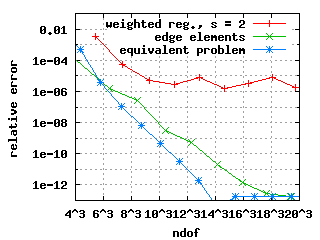
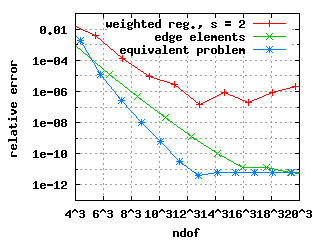
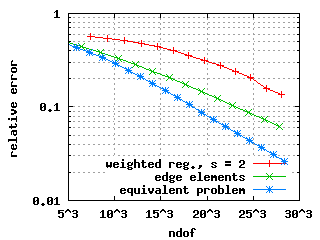
The edge elements and the equivalent problem show exponential convergence for the first three Eigenvalues in the above plots. The weighted regularisation only does so for the third Eigenvalue. The convergence histories for the first and second Eigenvalue deteriorate at a level of the relative error of 10-6. This does not depend on s, the chosen Eigenvalue solver (or its parameters) or the formulation of the constraints at the origin.
The third plot above shows the convergence history for the third Eigenvalue: It is approximated poorly. The reason is that the third Eigenfunction has a strong unbounded singularity at the origin. This can also be seen in the eigenvalues-s plot: The Eigenvalues computed with the weighted regularisation are above 20 for s >= 2 and even above 25 for s >= 16---the true value is expected to be close to 15.
Maxwell eigenvalues in 2DomE (Square for transmission problems, ε1 = 1e-8), (20040512)
Computed by a Galerkin approximation with a geometric mesh with increasing number of layers n and linearly distributed polynomial degree (between 2 in the smallest two layers and n+1 in the largest layer). We have used three different methods:
The same mesh was used for all three methods.

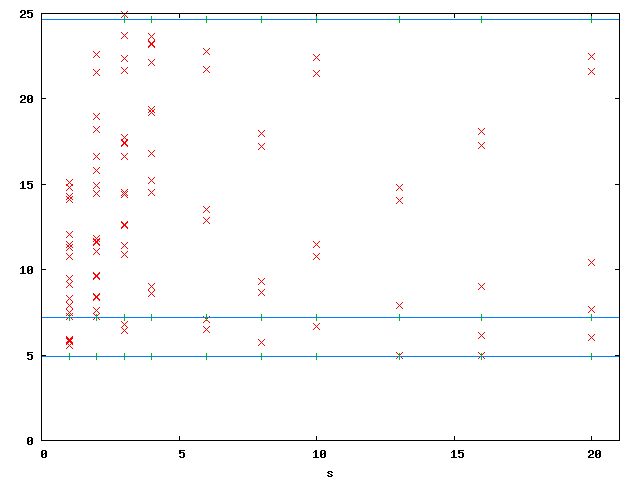
In the above plot (7680 dofs), red are spurious Eigenvalues, green are physical Eigenvalues, horizontal blue lines are 'exact' values from Benchmax. Below are the numeric values of the first three physical Eigenvalues for different number of layers n. We chose s = 6.
| Weighted Regularization with Node Doubling | Edge Elements | Equivalent Magnetic Problem | ||||||||||||||||||||||||||||||||||||||||||||||||||||||||
|---|---|---|---|---|---|---|---|---|---|---|---|---|---|---|---|---|---|---|---|---|---|---|---|---|---|---|---|---|---|---|---|---|---|---|---|---|---|---|---|---|---|---|---|---|---|---|---|---|---|---|---|---|---|---|---|---|---|---|
|
|
|
The convergence histories below for the 1st, 2nd and 3rd Eigenvalue
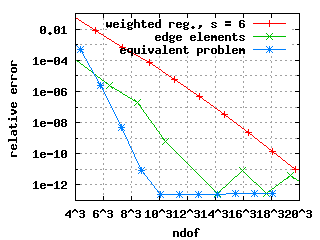
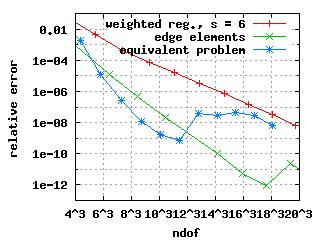
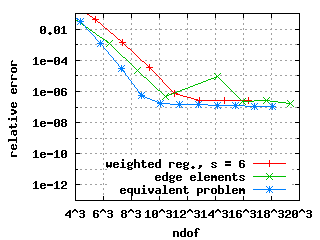
All three methods show exponential convergence for the first three Eigenvalues in the above plots with the following two exceptions:
Maxwell eigenvalues in 3DomA (thick L), (20031124)
Computed by a Galerkin approximation with a geometric mesh with increasing number of layers n and linearly distributed polynomial degree (between 1 in the smallest two layers and n in the largest layer). We used two different geometric grading parameters: σ = 0.5 and σ = 0.15.
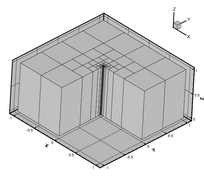
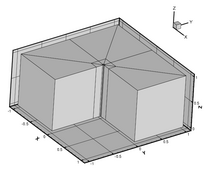
The mesh with σ = 0.5 on the left has hanging nodes and is automatically generated by refining geometrically towards the singular reentrant edge. The mesh with σ = 0.15 on the right is generated by and hand-written mesh generator and is regular (no hanging nodes).
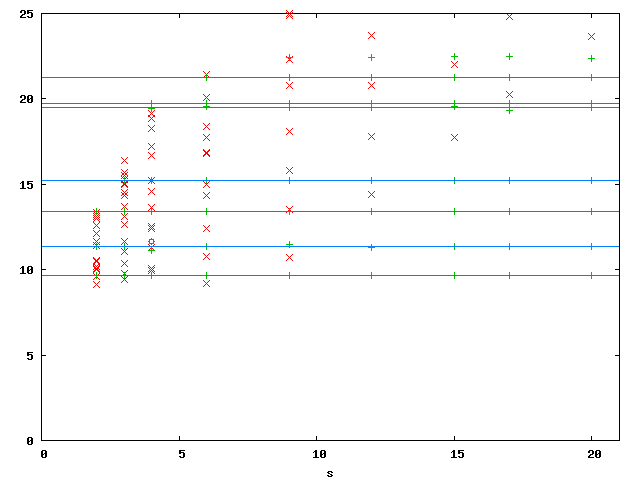
In the above plot (18726 dofs), red are spurious Eigenvalues, green are physical Eigenvalues, blue circles are undecided, horizontal blue lines are 'exact' values from Benchmax. Below are the numeric values of the first three physical Eigenvalues for different number of layers n. We chose s = 9.
|
N = 35 n = 2 | N = 262 n = 3 | N = 849 n = 4 | N = 2045 n = 5 | N = 4079 n = 6 |
|---|---|---|---|---|
| 11.7025800433922 | 9.93636033576106 | 9.703684287269 | 9.66199382740543 | 9.64832141646694 |
| 14.4482798347581 | 12.9453012604953 | 11.8771170013488 | 11.4414228545519 | 11.2979362655014 |
| 14.5879505606373 | 13.7176438766842 | 13.461396040052 | 13.4208624111407 | 13.4086701905748 |
|
N = 7273 n = 7 | N = 12003 n = 8 | N = 18726 n = 9 | N = 27953 n = 10 | N = 40276 n = 11 |
| 9.64311380519266 | 9.64106702614984 | 9.640256678357 | 9.63993527914001 | 9.63980775012728 |
| 11.2627948488678 | 11.2237331775842 | 11.4993572250657 | 11.3653194525692 | 11.3484229353869 |
| 13.4052388728482 | 13.4041732668983 | 13.4037883302838 | 13.4036686125225 | 13.4036417544865 |
|
N = 56341 n = 12 | ||||
| 9.63975714199179 | ||||
| 11.3448098681505 | ||||
| 13.4036367812583 |
|
N = 330 n = 2 | N = 1007 n = 3 | N = 2196 n = 4 | N = 4096 n = 5 | N = 6951 n = 6 |
|---|---|---|---|---|
| 9.66154237518914 | 9.64236934625773 | 9.63992566703802 | 9.63974748821976 | 9.63972630864826 |
| 11.6830348052992 | 11.3114906688245 | 11.4089339115341 | 11.3474108890186 | 11.3451931889982 |
| 13.5830928990752 | 13.4180982414251 | 13.4071878529517 | 13.4038647251574 | 13.4036551326599 |
|
N = 11041 n = 7 | N = 16700 n = 8 | N = 24298 n = 9 | ||
| 9.63972420070038 | 9.63972390048556 | 9.63972385325434 | ||
| 11.3446042886796 | 11.3458307118951 | 11.345288444485 | ||
| 13.4036373807275 | 13.4036359650574 | 13.4036350967918 |
The convergence histories below for the 1st, 2nd and 3rd Eigenvalue (top to bottom) show three different curves each for different values of s. The left and right plots show σ = 0.5 and σ = 0.15 respectively with the same scales! It is clearly visible that the mesh with σ = 0.15 beats the mesh with σ = 0.5. Note: the convergence histories for the different values of s are identical for the 1st Eigenvalue.
| σ = 0.5 | σ = 0.15 |
|---|---|
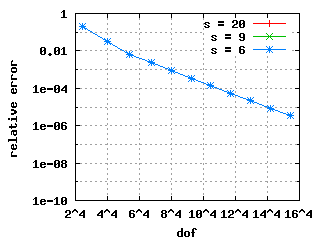 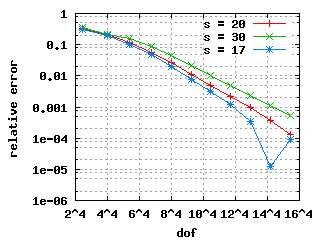 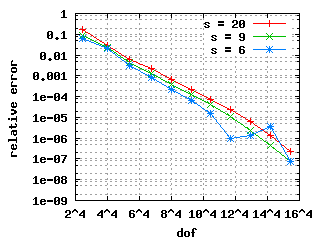
|
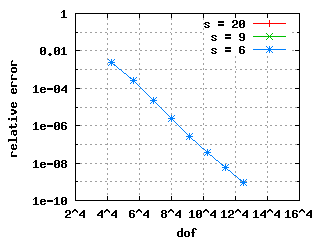 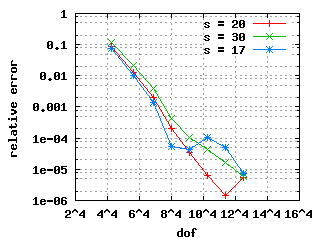 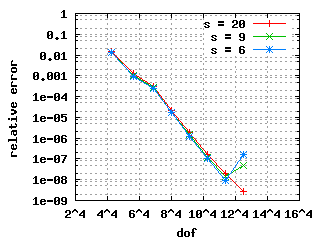
|
Maxwell eigenvalues in 3DomB (Fichera), (20031127)
Computed by a Galerkin approximation with a geometric mesh with increasing number of layers n and linearly distributed polynomial degree (between 1 in the smallest two layers and n in the largest layer).
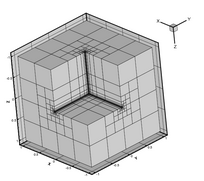
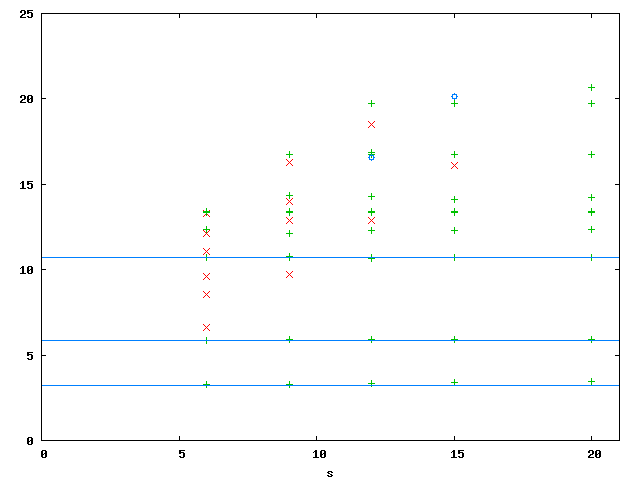
In the above plot (45450 dofs), red are spurious Eigenvalues, green are physical Eigenvalues, blue circles are undecided, horizontal blue lines are extrapolated values from the computations.
| 1st EV | 2nd EV | 3rd EV |
|---|---|---|
| 3.197 | 5.878 | 10.6955 |
Below are the numeric values of the first three physical Eigenvalues for different number of layers n. We chose s = 9.
|
N = 102 n = 2 | N = 990 n = 3 | N = 3882 n = 4 | N = 10551 n = 5 | N = 23325 n = 6 |
|---|---|---|---|---|
| 7.1844011718377 | 5.51951380126179 | 4.39519257419226 | 3.82778107840267 | 3.52738328207976 |
| 7.18440117183771 | 6.24240156443094 | 6.03298285023165 | 5.94356763192768 | 5.90513973333147 |
| 13.1062851040138 | 10.9763212873508 | 10.7529569081045 | 10.7138214384632 | 10.7010661314235 |
|
45450 n = 7 | N = 81285 n = 8 | |||
| 3.37237419820498 | 3.29778479761133 | |||
| 5.8899355428419 | 5.88424721054921 | |||
| 10.6963740435117 | 10.6945254229041 |
The convergence histories below for the 1st, 2nd and 3rd Eigenvalue
show three different curves each: for the values s = 9, s = 6 and s = 2.
